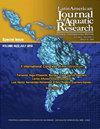Toxicity of secondary treated sewage disinfected with chlorine gas and hypochlorite to zebrafish Danio rerio
IF 0.8
4区 农林科学
Q3 FISHERIES
Latin American Journal of Aquatic Research
Pub Date : 2022-11-01
DOI:10.3856/vol50-issue5-fulltext-2893
引用次数: 0
Abstract
The sewage contains toxic chemical compounds that secondary treatment plants do not eliminate, and chlorine is usually added for disinfection before discharge. Chlorine reacts with sewage compounds forming other toxic compounds. The objective of this study was to evaluate the toxicity of treated sewage from a secondary treatment plant using Danio rerio embryos. Three types of treated sewage were tested, one disinfected with chlorine gas (dCl2), another with sodium hypochlorite (dClO), and the plant discharge, which is a mixture of the two sewage disinfection methods (mCl) with a proportion of 70% of dCl2 and 30% of dClO. To estimate the median lethal dilution treated sewage was diluted with dechlorinated tap water at 20, 40, 60, and 80%. Two additional points were made with pure treated sewage and pure dechlorinated tap water. Embryos were exposed 1 h after fertilization (hpf) to 144 hpf. The dCl2 and the mCl were lethal at 60 and 72 hpf, respectively, while the dClO did not show lethality. The embryos exposed to the mCl showed heart failure and slower blood circulation. Those exposed to dCl2 showed teratogenic effects such as pericardial edema and spinal curvature, while those exposed to dClO presented malformations such as incomplete eye development and otolith formation absence.氯气和次氯酸盐二次处理污水对斑马鱼的毒性
污水中含有二级处理厂无法消除的有毒化合物,通常在排放前添加氯进行消毒。氯与污水化合物反应形成其他有毒化合物。本研究的目的是评估使用灰尾鱼胚胎的二级处理厂处理过的污水的毒性。测试了三种处理过的污水,一种用氯气(dCl2)消毒,另一种用次氯酸钠(dClO)消毒,以及工厂排放,这是两种污水消毒方法(mCl)的混合物,其中dCl2和dClO的比例分别为70%和30%。为了估计中等致死稀释度,用脱氯自来水将处理过的污水稀释至20%、40%、60%和80%。另外两个要点是使用纯处理过的污水和纯脱氯自来水。胚胎在受精(hpf)后1小时暴露于144hpf。dCl2和mCl分别在60和72 hpf时是致命的,而dClO没有显示出致命性。暴露于mCl的胚胎表现出心力衰竭和血液循环减慢。接触dCl2的患者表现出致畸作用,如心包水肿和脊柱弯曲,而接触dClO的患者则表现出畸形,如眼睛发育不完全和耳石形成缺失。
本文章由计算机程序翻译,如有差异,请以英文原文为准。
求助全文
约1分钟内获得全文
求助全文
来源期刊

Latin American Journal of Aquatic Research
FISHERIES-MARINE & FRESHWATER BIOLOGY
CiteScore
1.70
自引率
10.00%
发文量
44
审稿时长
4-8 weeks
期刊介绍:
Latin American Journal of Aquatic Research- LAJAR is the continuation of the journal Investigaciones Marinas (1970-2007) and is published since 2008 by the Escuela de Ciencias del Mar, Facultad de Ciencias del Mar y Geografía of the Pontificia Universidad Católica de Valparaíso. LAJAR is an “Open Access” journal that publishes in English language, original research articles, reviews and short communications on aquatic science, which contain the results of research conducted in aquaculture or in oceanic and coastal marine waters of Latin America.
The following topics are considered: Physical Oceanography, Chemical Oceanography, Marine Biogeochemistry, Marine Pollution and Toxicology, Marine Geology and Geophysics, Biological Oceanography, Fisheries and Aquaculture.
 求助内容:
求助内容: 应助结果提醒方式:
应助结果提醒方式:


